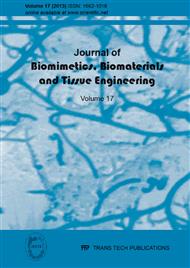[1]
K. Schwarz, M. Epple. Biomimetic Crystallization of Apatite in a Porous Polymer Matrix. Chemistry - A European Journal, (1998), 4 (10), 1898-1903.
DOI: 10.1002/(sici)1521-3765(19981002)4:10<1898::aid-chem1898>3.0.co;2-u
Google Scholar
[2]
F. Hosseinnejad, A.A Imani Fooladi, F. Hafezi, S. Mohit Mafi, A. Amiri, M.R Nourani. Modelling and Tissue Engineering of Three Layers of Calvarial Bone as a Biomimetic Scaffold. J. Biomim., Biomat. Tiss. Eng., (2012), 15, 37-53.
DOI: 10.4028/www.scientific.net/jbbte.15.37
Google Scholar
[3]
J.M Marentette, J. Norwig, E. Stöckelmann, W.H Meyer. Crystallization of CaCO3 in the presence of PEO-block-PMAA copolymers. Adv. Mater., (1997), 9 (8), 647-651.
DOI: 10.1002/adma.19970090813
Google Scholar
[4]
S. Teng, J. Shi, L. Chen. Formation of calcium phosphates in gelatin with a novel diffusion system. Colloids and Surfaces B: Biointerfaces, (2006), 49 (1), 87-92.
DOI: 10.1016/j.colsurfb.2006.03.005
Google Scholar
[5]
W. Zhang, S.S Liao, F.Z Cui. Hierarchical Self-Assembly of Nano-Fibrils in Mineralized Collagen. Chem. Mater. (2003), 15 (16), 3221-3226.
DOI: 10.1021/cm030080g
Google Scholar
[6]
A.L Boskey, M. Maresca, S. Doty, B. Sabsay, A. Veis. Concentration-dependent effects of dentin phosphophoryn in the regulation of in vitro hydroxyapatite formation and growth. Bone Miner., (1990), 11 (1), 55-65.
DOI: 10.1016/0169-6009(90)90015-8
Google Scholar
[7]
S.V Dorozhkin. Calcium Orthophosphates in Nature, Biology and Medicine. Materials, (2009), 2 (2), 399-498.
DOI: 10.3390/ma2020399
Google Scholar
[8]
S.V Dorozhkin. Nanosized and nanocrystalline calcium orthophosphates. Acta Biomater. (2010), 6 (3), 715-734.
DOI: 10.1016/j.actbio.2009.10.031
Google Scholar
[9]
R.Z LeGeros, in Hydroxyapatite and related materials, P.W. Brown, B. Constanz (Eds.): CRC Press, Boca Raton, (1994), 3-28.
Google Scholar
[10]
R.Z LeGeros. Calcium phospahtes in oral biology and medicine, in Monographs in Oral Science, Vol 15, (ed. H.M Myers), Karger, Basel, Switzerland (1991), p.122.
Google Scholar
[11]
F. Barrère, C.A van Blitterswijk, K. de Groot. Bone regeneration: molecular and cellular interactions with calcium phosphate ceramics. Int. J. Nanomedicine, (2006), 1 (3), 317-332.
Google Scholar
[12]
N. Monmaturapoj. Nano-size Hydroxyapatite Powders Preparation by Wet-Chemical Precipitation Route. Met. Mater. Miner., (2008), 18 (1), 15-20.
Google Scholar
[13]
R.Z LeGeros, J.P LeGeros. Dense Hyroxyapatite, in An Introduction to Bioceramics, L.L Hench, J. Wilson (Eds). World Scientific, Singapore, (1993), Vol. 1, pp.41-62.
Google Scholar
[14]
F. Ren, Y. Leng , R. Xin, X. Ge. Synthesis, characterization and ab initio simulation of magnesium-substituted hydroxyapatite. Acta Biomaterialia, (2010), 6 (7), 2787-2796.
DOI: 10.1016/j.actbio.2009.12.044
Google Scholar
[15]
J.L Drury, D.J Mooney. Hydrogels for tissue engineering: scaffold design variables and applications. Biomaterials, (2003), 24 (24), 4337-4351.
DOI: 10.1016/s0142-9612(03)00340-5
Google Scholar
[16]
C.Wang, Y. Gong, Y. Zhong, Y. Yao, K. Su, D.A Wang. The control of anchorage-dependent cell behaviour within a hydrogel/microcarrier system in an osteogenic model. Biomaterials, (2009), 30 (12), 2259-2269.
DOI: 10.1016/j.biomaterials.2008.12.072
Google Scholar
[17]
F. Hafezi, F. Hosseinnejad, A.A Fooladi, S.M Mafi, A. Amiri, M.R Nourani. Transplantation of nano-bioglass/gelatin scaffold in a non-autogenous setting for bone regeneration in a rabbit ulna. J. Mater. Sci. Mater. Med., (2012), 23 (11), 2783-2792.
DOI: 10.1007/s10856-012-4722-3
Google Scholar
[18]
A. Becker, A. Ziegler, M. Epple. The mineral phase in the cuticles of two species of Crustacea consists of magnesium calcite, amorphous calcium carbonate, and amorphous calcium phosphate. Dalton Transactions (2005), 21 (10), 1814-1820.
DOI: 10.1039/b412062k
Google Scholar
[19]
P.J Tannenbaum, H. Schraer, A.S Posner. Crystalline changes in avian bone related to the reproductive cycle. Calcif. Tissue Research, (1974), 14 (1), 83-86.
DOI: 10.1007/bf02060285
Google Scholar
[20]
S.B Idris, S. Dánmark, A. Finne-Wistrand, K. Arvidson, A-C. Albertsson, A.I Bolstad, K. Mustafa. Biocompatibility of Polyester Scaffolds with Fibroblasts and Osteoblast-like Cells for Bone Tissue Engineering. Bioactive and Compatible Polymers, (2010), 25 (6), 567-583.
DOI: 10.1177/0883911510381368
Google Scholar
[21]
M. Peter, N. Ganesh, N. Selvamurugan, S.V Nair, T. Furuike, H. Tamura, R. Jayakumar. Preparation and characterization of chitosan-gelatin/nanohydroxyapatite composite scaffolds for tissue engineering applications. Carbohydrate Polymers, (2010), 80 (3), 687-694.
DOI: 10.1016/j.carbpol.2009.11.050
Google Scholar
[22]
M. Azami, S. Tavakol, A. Samadikuchaksaraei, M.S Hashjin, N. Baheiraei, M. Kamali, M.R Nourani. A Porous Hydroxyapatite/Gelatin Nanocomposite Scaffold for Bone Tissue Repair: In Vitro and In Vivo Evaluation. J. Biomater. Sci. Polym. Ed., (2012) Jan 12. [Epub ahead of print].
DOI: 10.1163/156856211x617713
Google Scholar
[23]
M. Mozafari, M. Rabiee, M. Azami, S. Maleknia. Biomimetic formation of apatite on the surface of porous gelatin/bioactive glass nanocomposite scaffolds. Applied Surface Science, (2010), 257 (5), 1740-1749.
DOI: 10.1016/j.apsusc.2010.09.008
Google Scholar
[24]
L. Silverman, A.L Boskey. Diffusion Systems for Evaluation of Biomineralization. Calcif. Tissue Int., (2004), 75 (6), 494-501.
DOI: 10.1007/s00223-004-0019-y
Google Scholar
[25]
T. Kokubo, S. Yamaguchi. Bioactive layer formation on Metals and Polymers. In: Comprehensive Biomaterials. P. Ducheyne, K.E Healy, D.W Hutmacher, D.W Grainger, C.J Kirkpatrick (eds.), Elsevier, (2011), Vol. 1, 231-244.
DOI: 10.1016/b978-0-08-055294-1.00025-8
Google Scholar
[26]
H-S Ryu, K.S Hong, J-K Lee, D.J Kim, J.H Lee, B-S Chang, D-H Lee, C-K Lee, S-S Chung. Magnesia-doped HA/β-TCP ceramics and evaluation of their biocompatibility. Biomaterials, (2004), 25 (3), 393-401.
DOI: 10.1016/s0142-9612(03)00538-6
Google Scholar
[27]
M. Azami, M.J Moosavifar, N. Baheiraei, F. Moztarzadeh, J. Ai. Preparation of a biomimetic nanocomposite scaffold for bone tissue engineering via mineralization of gelatin hydrogel and study of mineral transformation in simulated body fluid. J. Biomed. Mater. Res. A., (2012), 100A (5), 1347-1355.
DOI: 10.1002/jbm.a.34074
Google Scholar
[28]
J.R Dorvee, A.L Boskey, L.A Estroff. Rediscovering Hydrogel-Based Double-Diffusion Systems for Studying Biomineralization. Cryst. Eng. Comm., (2012 ), 14 (18), 5681-5700.
DOI: 10.1039/c2ce25289a
Google Scholar
[29]
B.A Gotliv, L. Addadi, S. Weiner. Mollusk shell acidic proteins: in search of individual functions. Chembiochem., (2003), 4 (6), 522-529.
DOI: 10.1002/cbic.200200548
Google Scholar
[30]
Z. Pucar, B. Pokric, A. Graovac. Precipitation in gels under conditions of double diffusion. Critical concentrations of the precipitating components. Anal. Chem., (1974), 46 (3), 403-409.
DOI: 10.1021/ac60339a011
Google Scholar
[31]
J-B Park. The use of hydrogels in bone-tissue engineering. Med Oral Patol Oral Cir Bucal., (2011), 16 (1), e115-118.
DOI: 10.4317/medoral.16.e115
Google Scholar
[32]
B.K Mann. Biologic gels in tissue engineering. Clin. Plast. Surg., (2003), 30 (4), 601-609.
Google Scholar


